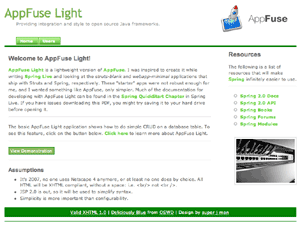 I'm extremely happy to announce we've finally finished developing AppFuse 2.0. The road to AppFuse 2.0 has been a long journey through Mavenland, annotations and generics. Thanks to all the developers, contributors and users for helping test, polish and prove that AppFuse 2 is an excellent solution for developing Java-based applications. Your time, patience and usage of AppFuse has made it the strong foundation it is today. Last but certainly not least, thanks to all the great Java developers who wrote the frameworks that AppFuse uses - we're truly standing on the shoulders of giants.
I'm extremely happy to announce we've finally finished developing AppFuse 2.0. The road to AppFuse 2.0 has been a long journey through Mavenland, annotations and generics. Thanks to all the developers, contributors and users for helping test, polish and prove that AppFuse 2 is an excellent solution for developing Java-based applications. Your time, patience and usage of AppFuse has made it the strong foundation it is today. Last but certainly not least, thanks to all the great Java developers who wrote the frameworks that AppFuse uses - we're truly standing on the shoulders of giants.
What is AppFuse? Click here to find out.
AppFuse is an open source project and application that uses open source tools built on the Java platform to help you develop Web applications quickly and efficiently. It was originally developed to eliminate the ramp-up time found when building new web applications for customers. At its core, AppFuse is a project skeleton, similar to the one that's created by your IDE when you click through a wizard to create a new web project.
AppFuse 1.x uses Ant to create your project, as well as build/test/deploy it. AppFuse 2.0 uses Maven 2 to create your project as well as build/test/deploy it. IDE support is much better in 2.0 because you can generate the IDE project files with Maven plugins. AppFuse 1.x uses XDoclet and JDK 1.4+.
This project was started in April 2003.
AppFuse 2.0 is available as a Maven archetype. For information on creating a new project using this release, please see the QuickStart Guide or the demos and videos.
If you've used AppFuse 1.x, but not 2.x, you'll might want to read our Frequently Asked Questions. If you have any questions or issues, please post them to the user mailing list. The Maven Reference Guide has a map of Ant » Maven commands. Maven for Newbies might also be useful if you've never used Maven before. There is some support for Ant in this release.
AppFuse 2.0 contains over 200 pages of documentation, downloadable as a PDF (3 MB). You can also download all its dependencies and install them in your local repository if you want to work offline.
For more information, please see the 2.0 Release Notes. The 2.0 series of AppFuse has a minimum requirement of the following specification versions:
- Java Servlet 2.4 and JSP 2.0 (2.1 for JSF)
- Java 5+
New features in AppFuse 2.0 include:
- Maven 2 Integration
- Upgraded WebWork to Struts 2
- JDK 5, Annotations, JSP 2.0, Servlet 2.4
- JPA Support
- Generic CRUD backend
- Full Eclipse, IDEA and NetBeans support
- Fast startup and no deploy with Maven Jetty Plugin
- Testable on multiple appservers and databases with Cargo and profiles
We appreciate the time and effort everyone has put toward contributing code and documentation, posting to the mailing lists, and logging issues.
We're also grateful for the help from our sponsors, particularly Atlassian, Contegix, JetBrains, and Java.net. Atlassian and Contegix are especially awesome: Atlassian has donated licenses to all its products and Contegix has donated an entire server to the AppFuse project. Thanks guys - you rock!
Comments and issues should be posted to the mailing list.






